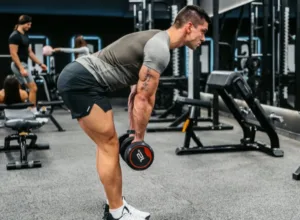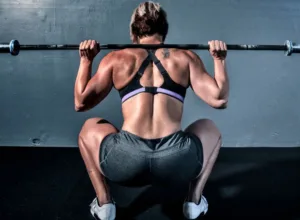You don’t need to spend hours in the gym to see results. You can build muscle in as few as one or two workouts a week, according to a conditioning expert and the latest exercise science.
By focusing on compound movements, efficient workout sets, and enough rest, you can max out your gains with minimal effort.
The image of sculpted physiques sculpted through hours of daily gym sessions is a pervasive one. But what if you don’t have the time or inclination to dedicate a large chunk of your day to working out? The good news is, achieving your fitness goals doesn’t require an all-or-nothing approach. Here’s why you can ditch the long gym sessions and still see fantastic results.
The Myth of Long Workouts
Science debunks the myth that extensive gym time is the key to fitness success. Studies have shown that shorter, focused workouts can be just as effective, if not more, for building muscle and improving cardiovascular health. Here’s why:
- Intensity Matters More Than Duration: It’s not just about the number of hours you spend moving; it’s about the intensity of your workout. Pushing yourself during your workout, whether through weight training or high-intensity interval training (HIIT), stimulates muscle growth and adaptation more effectively than going through the motions for an extended period.
- Focus on Quality Over Quantity: Long gym sessions can lead to overtraining, hindering progress and increasing the risk of injury. Shorter, well-structured workouts allow for proper form and technique, minimizing injury risk and maximizing results.
- Consistency is Key: The most crucial factor for fitness success is consistency. Aiming for shorter, more manageable workouts that you can realistically fit into your schedule is more sustainable in the long run than sporadic, lengthy sessions.
Making the Most of Your Time
So, how can you achieve your fitness goals with shorter workouts? Here are some key strategies:
- Embrace High-Intensity Interval Training (HIIT): HIIT involves alternating periods of intense activity with short rest intervals. This training style burns calories efficiently, boosts metabolism, and improves cardiovascular health in shorter durations compared to traditional cardio.
- Strength Training: Building muscle mass is crucial for boosting metabolism and overall fitness. Opt for compound exercises that work multiple muscle groups simultaneously, maximizing your time investment.
- Circuit Training: Combine strength training exercises with short bursts of cardio for a full-body workout that saves time and keeps your heart rate elevated.
- Bodyweight Exercises: Don’t underestimate the power of your own bodyweight. Bodyweight exercises like squats, lunges, push-ups, and planks require no equipment and can be done anywhere, anytime.
- Focus on Progressive Overload: To keep challenging your muscles and promoting growth, gradually increase the weight lifted, the number of repetitions performed, or the intensity of your workouts over time.
Check Out Our List Of The Best Supplements For Building Muscle, Shredding Muscle, Recovery, And Great Health, and Wellness Products! Purchase ifbnewsfeed.org‘s apparels Here: ifbnewsfeed.org

 You can build muscle with less exercise than you think, experts say
You can build muscle with less exercise than you think, experts say
Long or excessively frequent workouts may do more harm than good for gains, Mike Boyle, a strength and conditioning coach, told IFBNewsfeed.Org.
“If anyone is lifting for more than an hour, they’re probably doing way more than they need to,” he said.
He recommends three sets of 10 reps each as an effective baseline workload. For overall muscle growth, opt for compound movements that work multiple muscle groups at once, such as squats, deadlifts, pull-ups, and presses.
Repeating this formula twice a week on your target muscle groups is plenty, Boyle said.
Even in professional bodybuilding, “there are very few people who work each group more than twice a week,” he said. “Less probably equals more when it comes to strength and hypertrophy.”
Research also supports working smarter, not harder. Roughly 10 sets per muscle group per week could be considered the minimum for optimizing muscle growth, and athletes may benefit from less, said a position paper from the International Universities Strength and Conditioning Association published in August.
As little as one session a week may lead to results, the researchers wrote. They recommended no more than 10 sets per muscle group in a single workout; any more than that should be spread across days.
Evidence suggests, however, that a higher volume might be helpful for working on muscle imbalances or weaker areas.
Too much exercise can backfire
Research suggests that more time exercising doesn’t always lead to more gains.
Despite what celebrities or influencers might suggest, it’s not always effective to exercise muscle groups five times a week or with twice-a-day workouts.
You might even stall progress by overworking since too much exercise deprives your muscles of the rest they need to grow, experts previously told IFBNewsfeed.Org.
To build strength and muscle, increase your training intensity over time
The amount of exercise you need for gains also depends on your experience level. As you progress in fitness, you’ll need to continue challenging yourself to see improvement.
As a result, more experienced athletes may need to put in more work than gym newbies. But that doesn’t necessarily translate to longer hours — you can also add intensity by increasing the weight you lift, improving your form, or performing more advanced versions of movements.
It can be helpful to aim for the minimal effective dose of exercise, since the more gradually you ramp up your intensity, the less overall work you’ll need to do to see results, Chris Duffin, a powerlifter, previously told Insider.
Be realistic about aesthetic goals, and celebrate strength gains
One important caveat in building muscle to create a sculpted physique is that how you look is related to factors beyond how much you work out or which exercises you do. Genetics, for instance, can make a difference in how people gain muscle.
“Some people respond to just about everything, and some people are going to have a hard time with just about everything,” Boyle said.
It can be discouraging and unhelpful to compare yourself to fitness influencers or celebrities, especially when you don’t know their circumstances, he said. Instead, focus on what you can control: getting progressively stronger and working toward the best version of yourself.
Finding the Right Fit
There’s no one-size-fits-all approach to fitness. Experiment with different workout styles and find what works best for you and your schedule. Here are some additional tips:
- Consider In-Home Workouts: Numerous online resources offer free and paid workout programs designed for home exercise. This eliminates commute time and allows you to work out at your convenience.
- Explore Fitness Apps: Many fitness apps can guide you through workouts, track your progress, and offer personalized plans.
- Embrace the Outdoors: Activities like running, cycling, swimming, or team sports provide a fun and social way to get fit without feeling confined to a gym.
Remember: Consistency is key. Aim for at least 30 minutes of moderate-intensity exercise most days of the week, or shorter bursts of high-intensity activity. Listen to your body, take rest days when needed, and prioritize sleep for optimal recovery.
Wrapping Up
You don’t have to spend hours in the gym to achieve a healthy and fit lifestyle. By incorporating shorter, more focused workouts into your routine, along with proper diet and rest, you can reach your fitness goals efficiently and enjoy the journey.
More About When to Increase Weights for Optimal Muscle Growth Contents
- Muscle Development: How To Maximize Your “Muscle Growth” And “Physical Strength” By Training Twice Per Day
- Why Are “Physical Strength and Physical Conditioning” so Important In Your Gym Routine?

- A1Supplements.com – America’s Favorite Supplement Store.
- Shop Optimum Nutrition Energy: Anytime & Pre-Workout
- A1Supplements.com – Lose Fat, Gain Muscle!
For More News And Daily Updates, Follow IFBNewsfeed.Org on Facebook, Twitter, and Instagram. Comment, Like, And Share With Everyone Who May Need To Be Updated With The Most Recent Fitness/Bodybuilding/Powerlifting And CrossFit News.







